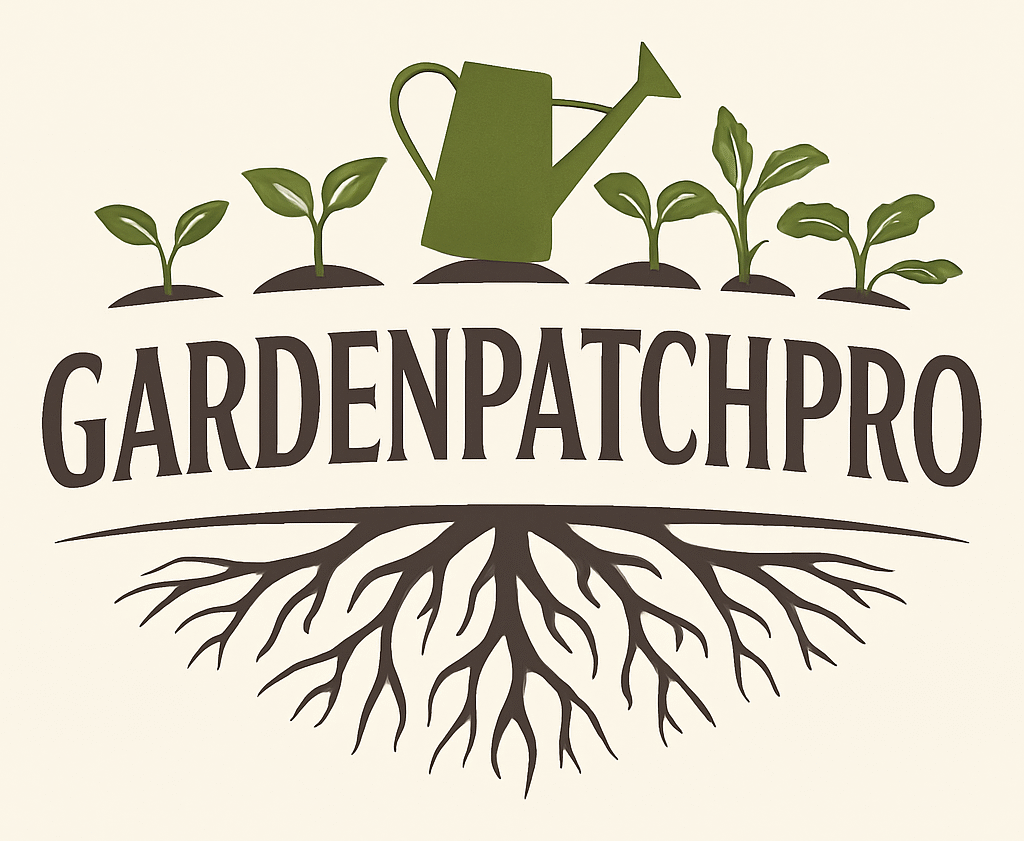15 Companion Plants For Tomatoes To Boost Growth And Pest Control
Tomatoes are a popular garden plant that benefits from being grown near certain other plants. Companion planting involves selecting plants that help each other grow better, stay healthy, and produce more fruit.
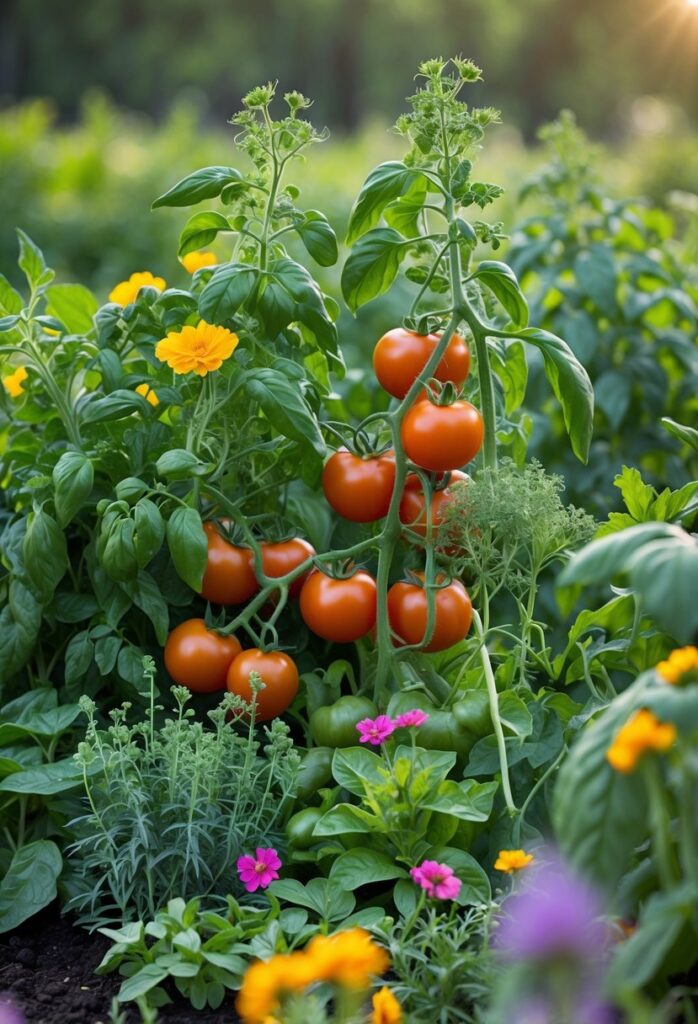
Companion plants for tomatoes can improve growth, reduce pests, and make harvesting easier. Gardeners often use this natural method to create a stronger, healthier tomato crop without relying on chemicals.
1) Basil
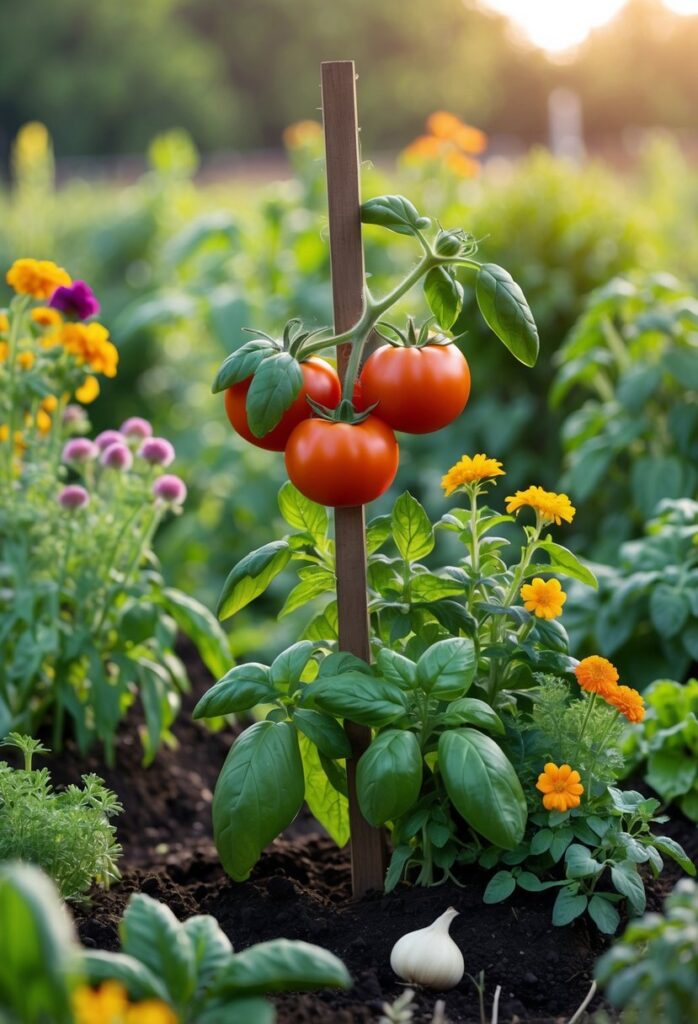
Basil is one of the most popular companion plants for tomatoes. It grows well near tomato plants and helps keep harmful insects like whiteflies, thrips, and hornworms away.
The leafy nature of basil provides ground cover. This helps keep the soil moist and reduces weed growth. Keeping weeds down means tomatoes can get more nutrients and water.
Basil also seems to improve the flavor of nearby tomatoes. Growing them together can even increase the yield for both plants. This makes basil not just good for pest control but also beneficial for growth.
Gardeners often plant basil right next to tomatoes to take advantage of these benefits. It works well in both garden beds and containers. For more details on why basil pairs well with tomatoes, see this guide on tomato companion plants.
2) Garlic
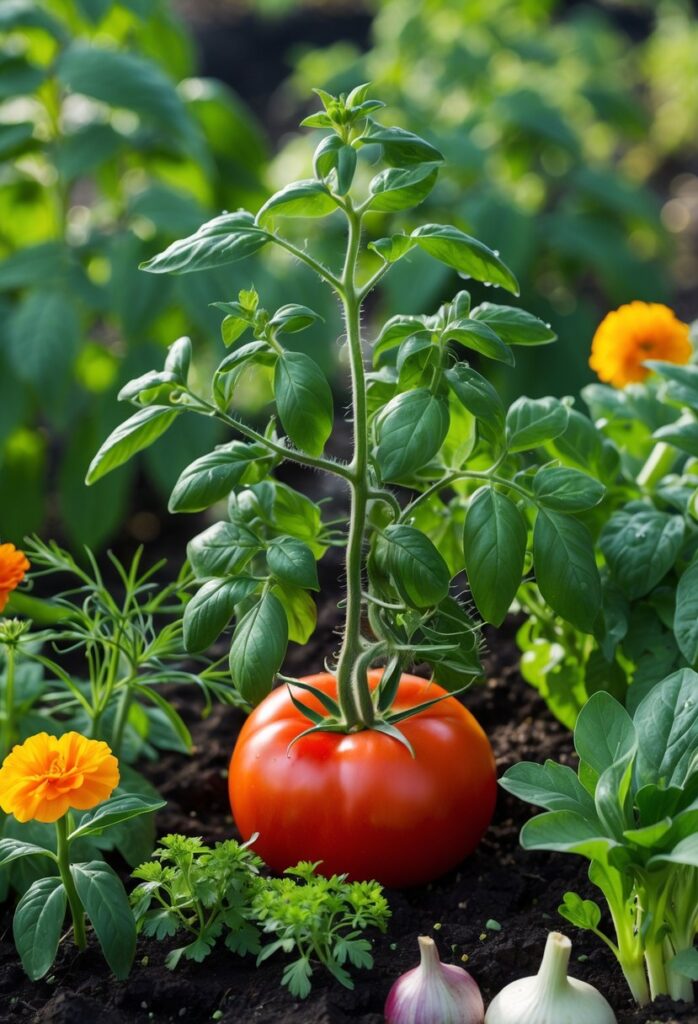
Garlic is a strong companion plant for tomatoes. It helps keep certain insects away, reducing the need for chemical pesticides. This natural pest control supports healthier tomato plants and a better harvest.
When planted near tomatoes, garlic does not compete for space or nutrients. Both plants grow well together and improve each other’s growth.
Garlic also has a natural scent that pests dislike. This smell can protect tomatoes from harmful bugs like aphids and spider mites.
Besides pest control, garlic can improve soil health. Its roots help reduce harmful soil fungi, creating a better environment for tomatoes to thrive.
For gardeners, combining garlic and tomatoes is an effective strategy. It is simple, practical, and works well in home gardens, offering a natural way to support tomato plants.
More details about using garlic with tomatoes can be found on gardenerspath.com.
3) Marigold

Marigolds are a popular companion plant for tomatoes. They bloom from early summer until the first frost, adding color to the garden.
They help protect tomato plants by repelling many common pests. Marigolds can reduce the number of harmful insects like nematodes and whiteflies near the tomatoes. This helps tomatoes grow stronger and healthier.
Both marigolds and tomatoes thrive in full sun and well-drained soil. Their similar growing needs make them easy to plant together. The marigold’s roots release substances that may improve soil health and reduce harmful pests.
Gardeners often use marigolds to create a pest-resistant tomato garden. Marigolds add value without needing extra care, making them practical for both home and kitchen gardens.
For more details on how marigolds work well with tomatoes, see marigold and tomato companion planting and why you should plant marigold with tomatoes.
4) Borage
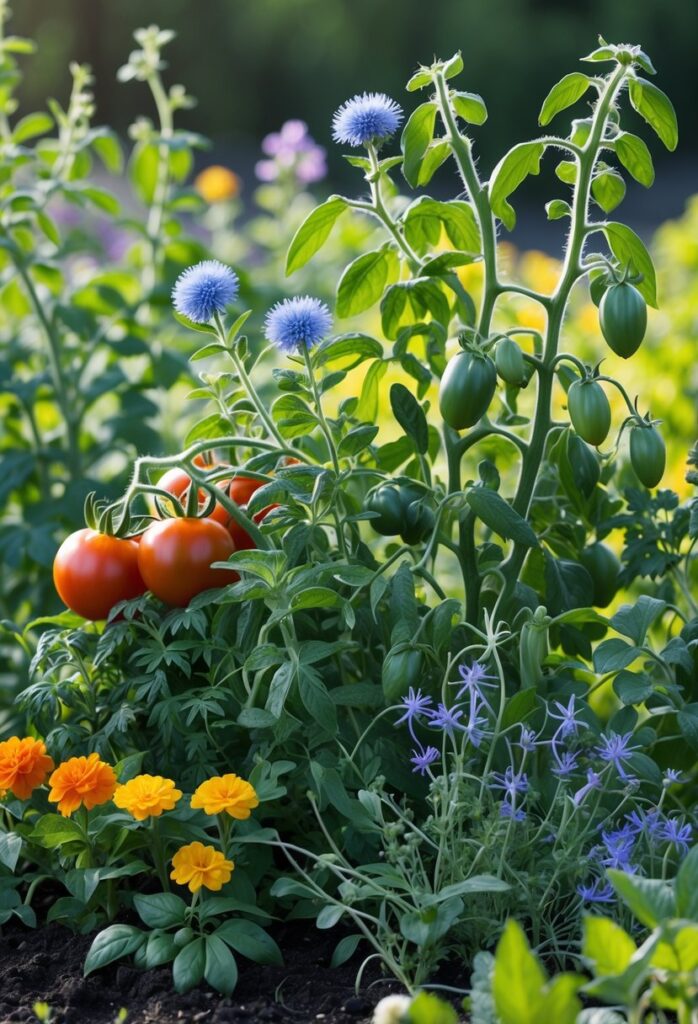
Borage is a helpful companion plant for tomatoes. It attracts pollinators like bees and butterflies, which improves tomato fruit production.
This herb adds nutrients to the soil, especially minerals that benefit tomato growth. It also helps repel some pests that bother tomatoes.
Borage grows well next to tomatoes because it does not compete for space or resources. Its flowers add color to the garden while supporting healthy plant relationships.
Gardeners should avoid planting borage near potatoes or fennel, but it pairs well with tomatoes and several other vegetables. It is a low-maintenance plant that self-seeds, making it easy to keep in the garden.
For more details on growing borage with tomatoes, see the guide on best companion plants for borage.
5) Chives

Chives are a popular companion plant for tomatoes. They help repel pests like aphids and other insects that often harm tomato plants. This natural pest control reduces the need for chemical sprays.
Chives also have mild antifungal properties. They can help protect tomatoes from some fungal diseases, which keeps the tomato plants healthier. This supports better growth and fruit production.
Planting chives near tomatoes can improve the flavor of the tomatoes. Many gardeners notice a slight boost in taste when these two grow close together. This is a benefit for those growing tomatoes for fresh eating.
Chives do not compete much for nutrients or space. They grow well in small clumps between tomato plants. Their roots do not interfere with tomato roots, making them a compatible neighbor in the garden.
For more on how chives and tomatoes work well together, you can visit this guide on companion plants for tomatoes.
6) Carrots

Carrots make good companions for tomatoes. They help improve the soil by breaking it up with their roots. This allows tomato roots to get better air and water flow.
Tomatoes, in return, provide light shade to carrots. This helps keep carrot roots cool, which slows down bolting in hot weather. Bolting can cause carrots to become bitter and tough.
Planting carrots near tomatoes can also help reduce pests. Carrots have a mild smell that can confuse some insect pests drawn to tomatoes. This benefits both plants and supports a healthier garden.
Carrots grow well alongside tomatoes because they do not compete much for space. Their growing needs, like water and nutrients, are different enough to avoid problems. This makes them a practical pairing for gardeners looking to maximize their space.
For more detailed tips on growing carrots with tomatoes, visit the guide on companion plants for carrots or the article about planting carrots next to tomatoes.
7) Onions
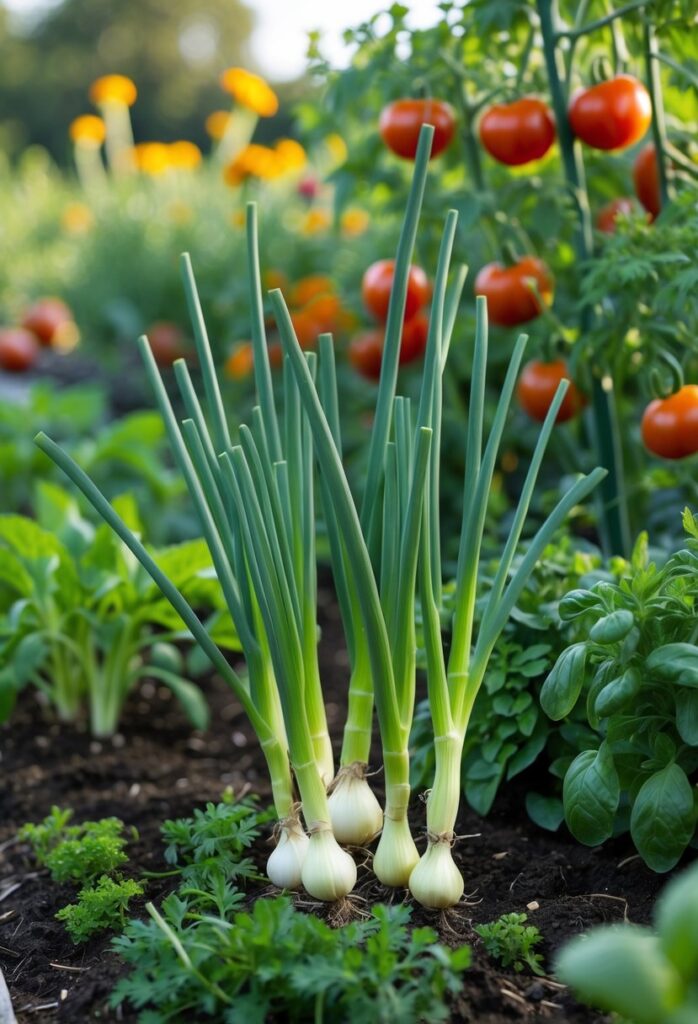
Onions are a good companion plant for tomatoes. They help repel pests like aphids and tomato hornworms that can damage tomato plants. This natural pest control can reduce the need for chemical treatments.
Onions have shallow roots, so they do not compete much with tomatoes for nutrients or water. Tomatoes have deeper roots, allowing both plants to grow well side by side. This helps maximize space in the garden.
Planting onions near tomatoes can also improve the flavor and yield of the tomatoes. The strong smell of onions confuses pests and keeps them away from tomato plants. They also attract beneficial insects that help pollinate tomatoes.
It’s important to plant onions and tomatoes with enough space between them to avoid overcrowding. Onions grow best in full sun, just like tomatoes. Both plants have similar care requirements, which makes them a practical pairing for gardeners.
For more details on the benefits of combining onions and tomatoes, check this guide on growing tomatoes and onions as companion plants.
8) Parsley
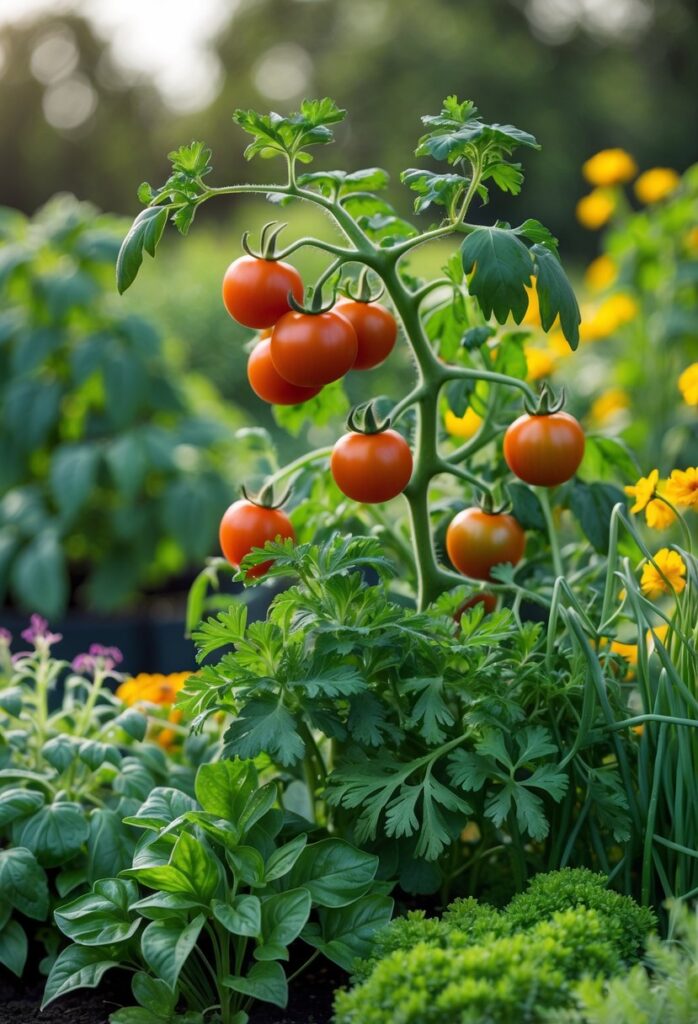
Parsley is a helpful companion plant for tomatoes. It attracts beneficial insects that prey on pests like aphids and tomato hornworms. This natural pest control can reduce the need for chemical treatments.
It also draws pollinators such as bees. These pollinators help improve tomato fruit production and overall garden health.
Parsley can improve the flavor and yield of tomatoes when grown nearby. It grows easily and fits well in most garden layouts.
Growing parsley next to tomatoes supports a balanced garden ecosystem. This pairing offers both pest management and better crop growth.
For more details on why parsley pairs well with tomatoes, see this parsley companion plants guide.
9) Nasturtium
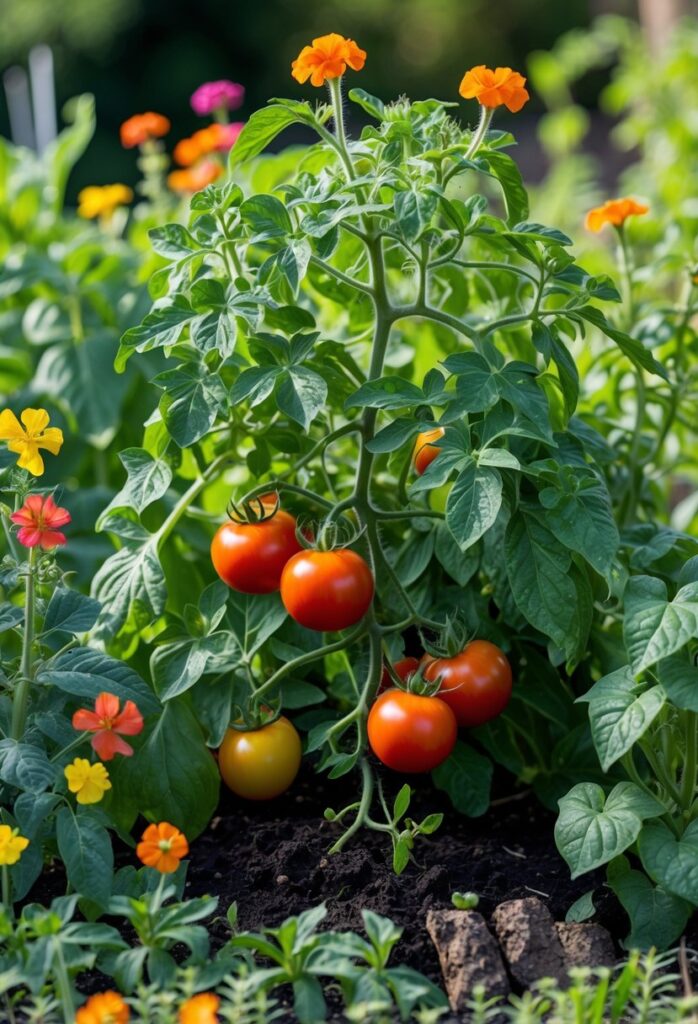
Nasturtiums are well-known companion plants for tomatoes. They help protect tomatoes by attracting pests like aphids and whiteflies away from the tomatoes themselves. This makes nasturtiums a natural pest control option.
They also attract pollinators, which can improve the overall health of the garden. Nasturtiums provide ground cover, helping to keep the soil moist and reduce weeds near tomato plants.
Planting nasturtiums near tomatoes can improve tomato growth and reduce pest problems without using chemicals. However, they need enough space and proper care to thrive alongside tomatoes.
Nasturtiums and tomatoes work well because both benefit from this partnership. While nasturtiums attract pests away, tomatoes grow better with less damage. This relationship makes nasturtiums a popular tomato companion in many gardens. For more details on using nasturtiums with tomatoes, see this guide on companion planting.
10) Calendula
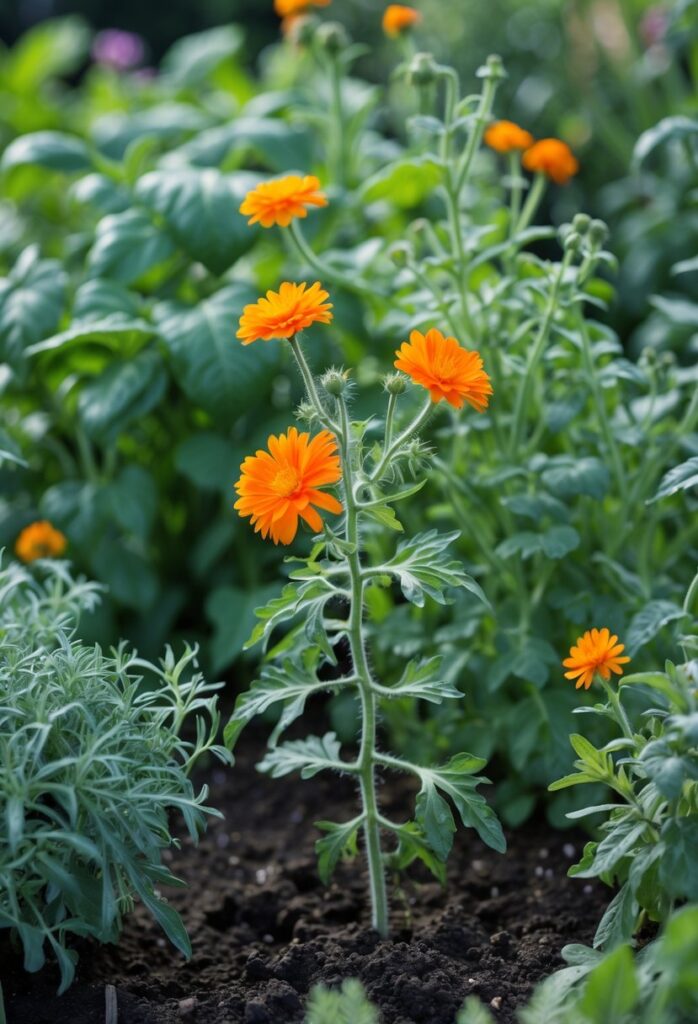
Calendula, also known as pot marigold, is a useful companion plant for tomatoes. It thrives in sunny spots with well-drained soil, similar to tomatoes.
Its bright flowers attract helpful insects like bees, hoverflies, and lacewings. These insects help control pests such as aphids that commonly affect tomato plants.
By planting calendula near tomatoes, gardeners can reduce pest problems naturally. It also supports pollination, which can improve tomato fruit production.
Calendula is easy to grow and adds color to the garden. Its presence can lead to healthier tomato plants and a more balanced growing environment.
More details on the benefits of calendula can be found in this guide to tomato companion plants.
11) Spinach

Spinach is a good companion plant for tomatoes. It grows well in the shade provided by taller tomato plants. This helps spinach avoid direct sunlight, which it does not like.
Spinach also has shallow roots. It does not compete much with tomatoes for nutrients or water. This makes them a good match in the garden.
Planting spinach near tomatoes can help make better use of garden space. The quick growth of spinach fills in empty spots early. This can reduce weed growth around tomato plants.
Spinach does not attract pests that harm tomatoes. It can also help improve soil health when its leaves and roots break down.
Overall, spinach works well alongside tomatoes to improve garden efficiency without interfering with tomato growth. This pairing suits gardeners who want to grow many plants in a limited area.
Learn more about good spinach companions at 15 Spinach Companion Plants for a Healthier Crop.
12) Lettuce
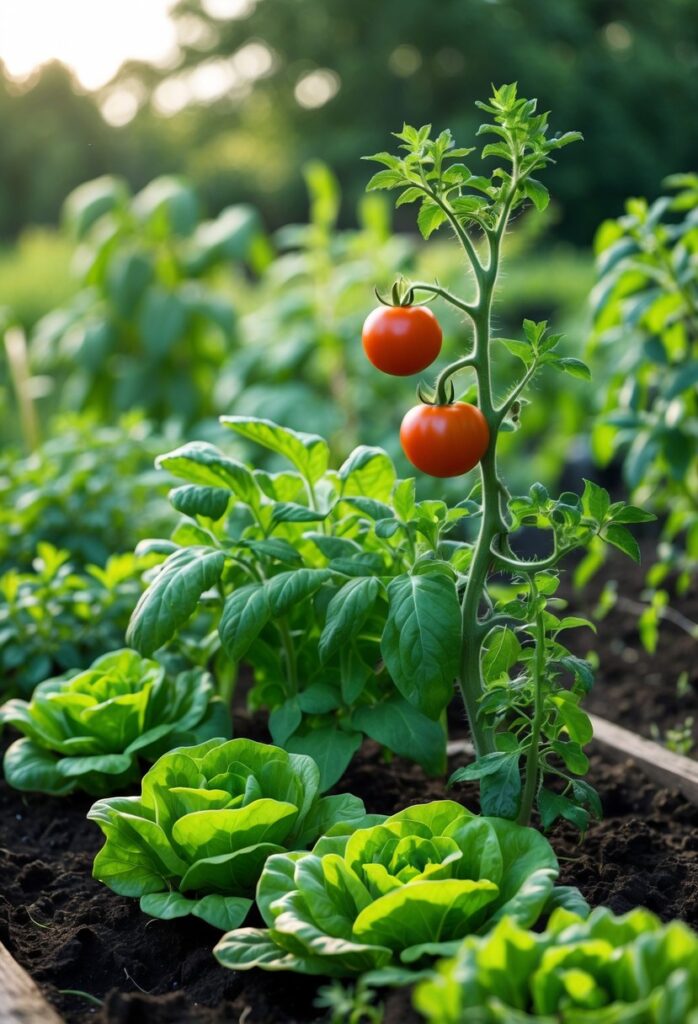
Lettuce is a good companion plant for tomatoes because it grows well in their shade. Tomatoes can provide enough shade to protect lettuce from the hot sun, helping it stay tender and fresh.
Lettuce and tomatoes do not compete much for nutrients. This means they can grow close together without hurting each other’s growth. It is still a good idea to plant them about 6-12 inches apart to give each enough space.
Lettuce also helps keep the soil moist by covering the ground. This can lower the chance of weeds growing near tomato plants. Together, they create a healthier environment in the garden.
Using lettuce as a companion plant can improve the overall use of garden space. This pairing works well for gardeners who want to grow more food in smaller areas. For more details on combining these plants, see companion planting for tomatoes and lettuce.
13) Asparagus
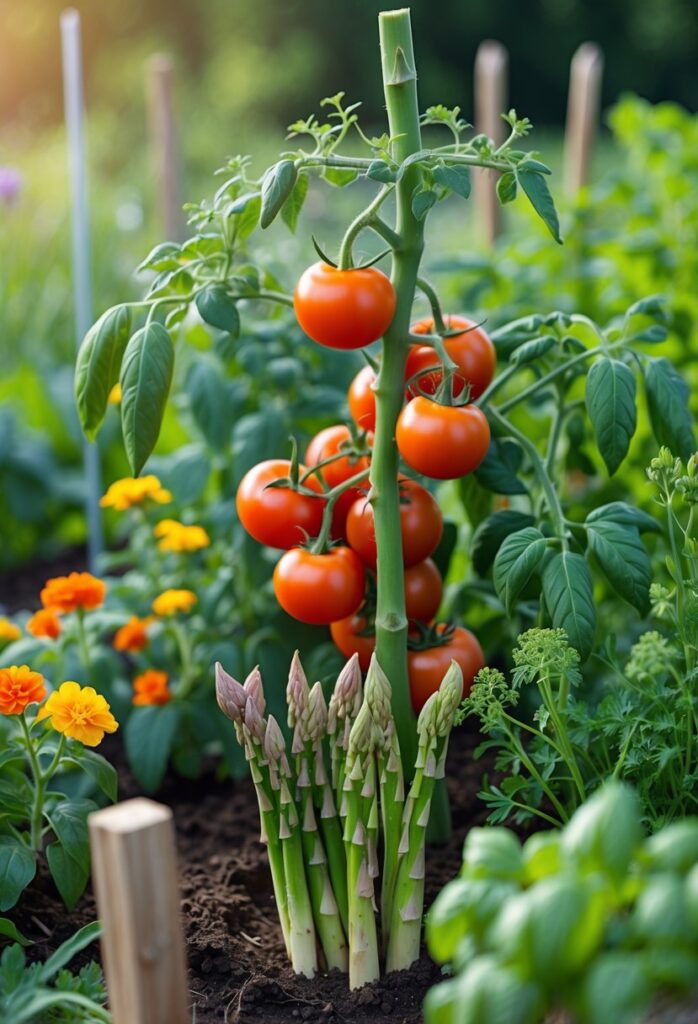
Asparagus is a strong companion plant for tomatoes. It helps by deterring nematodes, which are pests that can harm tomato roots. This makes tomatoes healthier and can improve their growth.
Tomatoes, in return, produce natural chemicals called saponins. These chemicals help repel asparagus beetles, a common pest that damages asparagus. Together, they protect each other from different threats.
Growing asparagus near tomatoes can also make good use of garden space. Asparagus grows tall and slow, while tomatoes grow faster and bushier. This helps both plants get enough sunlight without crowding each other.
Despite asparagus needing more care than some companion plants, its benefits with tomatoes make the effort worthwhile. They build a mutual relationship that supports healthier plants. For more on beneficial pairings like this, see 12 Best Asparagus Companion Plants (And 5 You Should Avoid).
14) Marjoram

Marjoram is a good companion plant for tomatoes. It grows well alongside tomatoes because it shares similar needs like plenty of sun and well-drained soil. The taller tomato plants can even provide some shade for marjoram during hot afternoons.
This herb helps tomatoes by keeping pests away. It also supports better growth for both plants when grown near each other. Marjoram can improve the flavor and health of tomatoes by attracting pollinators and beneficial insects.
It is best to avoid planting marjoram near fennel or sage. These plants compete with marjoram for nutrients and can slow its growth. Marjoram also benefits from being planted near stinging nettle, which can boost its essential oils and strengthen its scent.
For gardeners wanting healthier tomatoes and herbs, adding marjoram to the garden can be a simple and effective choice. More on effective tomato companion plants is available at The Spruce’s list of best companion plants for tomatoes.
15) Sunflowers

Sunflowers work well as companion plants for tomatoes. They attract pollinators like bees and birds, which help improve tomato fruit production. This makes the garden more productive and lively.
Sunflowers can also provide some shade for tomatoes during hot afternoons. This helps protect the tomato plants from too much sun, keeping them from stress. The tall sunflowers grow well without blocking too much light from the tomatoes.
Gardeners sometimes use sunflower stalks as natural stakes for cherry tomatoes. This saves space and materials while supporting the tomato plants effectively. Both plants benefit from this practical pairing in the garden.
Planting sunflowers near tomatoes is a simple way to support healthy growth. Many gardeners find this combination beneficial for pest control and improving pollination. More details about planting sunflowers with tomatoes can be found at 15 companion plants for tomatoes.
How Companion Plants Benefit Tomatoes
Companion plants help tomatoes in many ways. They protect tomatoes from pests, improve the soil, and boost the plants’ growth and fruit production. These benefits work together to create a stronger, healthier tomato crop.
Pest Control Advantages
Certain companion plants can keep pests away from tomato plants. For example, basil and marigolds produce smells that repel insects like aphids, whiteflies, and tomato hornworms.
Some companions attract beneficial insects such as ladybugs and bees. Ladybugs eat harmful pests, while bees improve pollination, which helps tomatoes produce more fruit.
Using companion plants for pest control reduces the need for chemical pesticides. This keeps the garden safer for people, pets, and helpful insects.
Soil Health Improvement
Some companion plants improve soil quality for tomatoes. Legumes like beans and peas add nitrogen to the soil, which tomatoes need to grow strong.
Deep-rooted plants like carrots help aerate the soil. This allows roots to get more oxygen and water.
Ground cover plants, such as clover, reduce weed growth and keep the soil moist by acting as a natural mulch. Better soil conditions lead to healthier tomato plants.
Enhanced Growth and Yield
Companion plants can boost tomato growth and fruit yield. They create a supportive environment by improving nutrient availability and reducing stress on tomato plants.
Herbs like basil not only protect tomatoes but also enhance their flavor. Many gardeners say tomatoes taste better when grown near certain companion plants.
Additionally, planting flowers around tomatoes attracts pollinators, which can increase both the number and size of tomatoes harvested. This makes companion planting a practical way to get more from a garden.
For more details on companion plants that improve tomatoes, visit 15 Best Tomato Companion Plants Every Gardener Should Know and The 21 Best (and 7 Worst) Companion Plants for Tomatoes.
Tips for Successfully Pairing Tomato Companion Plants
Choosing the right space and planting methods is important to help companion plants and tomatoes grow well together. Proper watering and nutrient care also supports healthy growth without competition or disease.
Spacing and Planting Techniques
Tomatoes need room to spread their roots and stems. Companion plants should be spaced to avoid crowding. For example, herbs like basil can be planted close, but larger plants such as sunflowers require more distance.
Using vertical space is helpful. Peas or beans can climb trellises, which keeps the ground clear for tomato roots. This minimizes overcrowding and reduces the risk of disease.
Rotating where tomatoes are planted each year lowers pests and disease buildup. Companion plants with different root depths can share soil space without competing for nutrients.
Pay attention to height and sunlight. Taller plants shouldn’t shade tomatoes. Place shorter plants where they get enough light. Maintaining airflow around tomatoes also helps prevent mold.
Water and Nutrient Considerations
Tomatoes need regular watering, but overwatering can harm both tomatoes and companions. Drip irrigation or soaker hoses deliver water directly to roots and reduce leaf wetness, lowering disease risk.
Some companion plants fix nitrogen, like peas, which naturally enrich the soil for tomatoes to use. Avoid planting heavy feeders near tomatoes to reduce competition for nutrients.
Mulching helps keep soil moist and controls weeds. Organic mulches also improve soil quality over time.
It’s important to observe plants for signs of stress. If companion plants seem to take too much water or nutrients, adjustments in watering or fertilizing may be needed to balance growth.
More detailed companion planting guidelines can be found in this tomato companion planting guide.
Frequently Asked Questions
Tomato gardeners often want to know which plants help keep pests away, which flowers and herbs grow well nearby, and if any plants should be avoided. They also ask how companion plants affect other vegetables and what works best in containers.
What are the best companion plants to grow with tomatoes to deter pests?
Plants like basil, garlic, and marigold are effective at repelling pests. Garlic emits a strong smell that deters insects. Marigolds are known to keep harmful nematodes and some insects away.
Can you list some flowers that serve as effective companions for tomato plants?
Marigold is the most popular flower companion. Borage is another helpful flower that attracts pollinators and can improve tomato growth. Both also help keep pests away.
Which herbs can be planted alongside tomatoes to promote healthy growth?
Basil is widely used to improve tomato flavor and growth. Chives also help repel pests and may improve tomato health. These herbs are easy to grow near tomatoes.
Are there companion plants that should be avoided when growing tomatoes?
Certain plants like corn and fennel do not grow well near tomatoes. They may attract pests or compete for nutrients, reducing tomato growth and health.
How does companion planting with tomatoes benefit other vegetables in the garden?
Companion plants around tomatoes can improve soil quality and reduce pests, which benefits nearby vegetables. For example, basil or marigold planted near peppers or eggplants supports their growth.
What are some suitable companion plants for tomatoes when using container gardening methods?
Small herbs like basil and chives work well in containers with tomatoes. Marigolds and borage also fit container gardens, helping with pest control and pollination while not overcrowding the space.
For more details about choosing the right plants, visit this list of 15 best companion plants for tomatoes.
